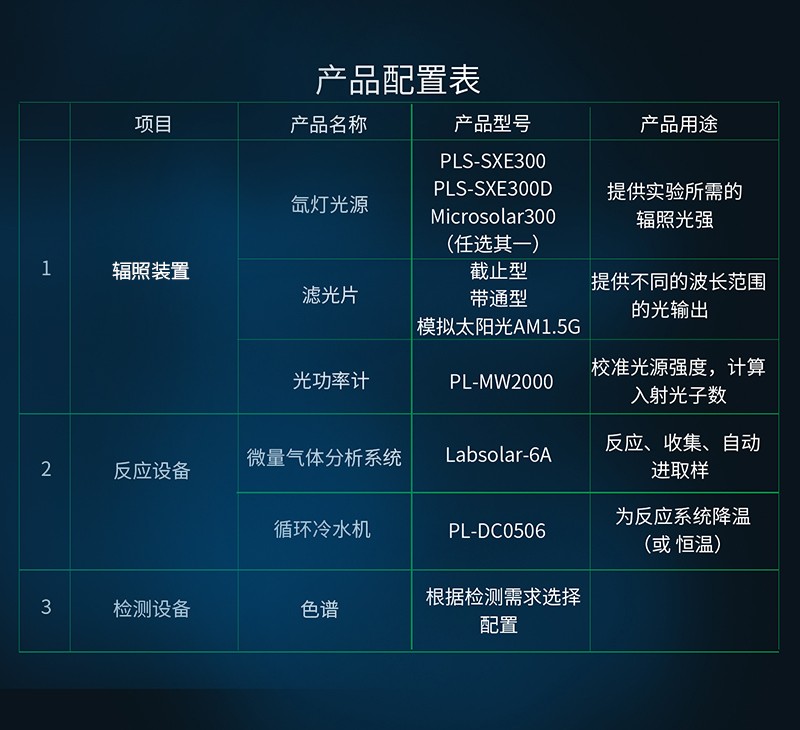Project Introduction:
The performance evaluation of catalysts for photocatalytic water decomposition is usually conducted in a closed vacuum glass system, and the gas production rate is typically at the μmol/h level. Therefore, the entire system needs to have good negative pressure and atmospheric pressure air tightness to prevent the inhibition of reactions by oxygen in the external air or the impact on the accuracy of oxygen production detection. Additionally, the adsorption of trace gases by metals is another significant factor causing experimental inaccuracies. Therefore, the entire reaction system, including the sampling section, must avoid the use of metal materials as much as possible.
All four configuration options provided in this proposal avoid the aforementioned issues.
Configuration One: Xenon lamp light source + Labsolar-6A + gas chromatography
Configuration Two: Xenon lamp light source + Labsolar-ⅢAG + gas chromatography
Configuration Three: Photocatalysis workstation

Advantages of the Proposal:
1. Glass multi-channel sampling valve (built-in quantitative ring) + automatic actuator, achieving the automation of sampling and injection on glass valves in a groundbreaking manner; providing a structural basis for cycle efficiency while ensuring air tightness. Avoids placing the sampling valve on the chromatograph, eliminates glass pipeline adsorption within the circulation circuit, and provides lower gas resistance, making it more conducive to the circulation of sample gas;
2. Built-in instrument methods, only requiring the setting of sampling cycles and counts, simple operation; fully automated sampling process, achieving 24-hour unattended operation, saving researchers' time; manual operation capabilities are also retained;
3. Small system circulation volume, about 300 mL, using a high-throughput magnetic plunger pump for rapid circulation, achieving uniform gas circulation in about 5 minutes. More sample points for product detection can be taken in the same reaction period;
4. Excellent air tightness, oxygen leakage within 24 hours < 3 μmol, ensuring the accuracy of experimental testing and accuracy of oxygen production experiments;
5. Linear regression of standard curves: Within the hydrogen production range of 100 μL to 10 mL, the system's r-value ≥ 0.999; repeated sampling RSD < 3%;
6. Outstanding expandability and compatibility, rich reactor library, enabling gas-solid phase experiments (with in-situ temperature measurement) through reactor replacement, or coupling with PEC2000 for online measurement of gas and electrical signals in Faraday efficiency;
7. Multi-functional quantitative buffer gas storage device, system capacity can be adjusted to accommodate different gas production requirements for system sampling volume;
8. Real-time measurement of system status, Labsolar 6A photocatalytic test device monitors system operation parameters such as reaction gas pressure, temperature, and automatic multi-channel valve status. Combined with the above points, ensures system accuracy and repeatability;
9. Complete system delivery, portable installation, no need for on-site open flame welding, ensuring laboratory safety;
10. Metal protective casing, providing protection for system glass components, radiation, and potential reaction gas leaks. Glass pipelines are no longer exposed, and the appearance is elegant and compact, with dimensions of only 490×520×740 mm.


Advantages of the Proposal
1. Classic structural design, numerous satisfied users, high cost-effectiveness;
2. All-glass material, fundamentally eliminating errors caused by metal adsorption in experimental results;
3. Dual six-channel injection valve, preventing carrier gas misextraction, ensuring accurate sampling;
4. Quantitative ring of about 1.5 ml, large sample volume, high sensitivity;
5. Multi-functional quantitative buffer gas storage device, system capacity adjustable;
6. Complete system delivery, portable installation, no need for on-site open flame welding, ensuring laboratory safety;
7. Outstanding expandability and compatibility, compatible with photoelectrochemical testing, expandable for carbon dioxide reduction experiments;
8. Equipped with a 300W xenon lamp light source, simulating solar light output, light power density reaching 1500-2000mw/cm2

The photocatalysis workstation is a versatile modular system, including:
Pre-processing unit Multi-gas atmosphere controller PLA-MAC1005
Multi-functional reaction unit Multi-channel PCX50C
Automatic sampling unit Automatic sampler PLA-GPA1000
Detection and analysis unit Gas chromatograph
Advantages of the Proposal
1. High efficiency, fully automated 9-parallel reactions, sampling, and analysis;
2. Cost-effective, one unit for nine, saving time and budget;
3. Fully automatic sampling, avoiding system errors caused by manual sampling;
4. Multiple wavelength lamp disks available, catering to different needs; modular design, easy and convenient lamp disk updates; multiple wavelength options, customizable wavelength combinations;
5. Reliable parallelism and comparability, utilizing the internationally patented bottom illumination method (Patent: 6348666), where incident light enters from the optical-grade bottom of the vessel. In comparison to the side-wall illumination method used by other manufacturers, bottom illumination to some extent reduces light diffusion and reflection. This provides a structural basis for data parallelism and comparability;
6. Diverse capabilities, catalyst performance screening (hydrogen production, oxygen production, complete water decomposition, carbon dioxide reduction, etc.), experimental condition optimization (temperature, humidity, pressure, concentration, light intensity, etc.);
7. Utilization of efficient and long-lasting micro pumps, maintenance-free; reaction vessels are less prone to damage compared to glass racks; maintenance and operational costs are nearly negligible;
8. Can be evacuated and pressure within the vessel can be set at different gradients or the same pressure within a range, facilitating flexible material testing under various conditions;
9. Vacuum pumping and inert gas filling operate automatically, stopping automatically. Once the sample handling logic is set, it can be directly called in the future. All reaction vessels can be processed rapidly, in a matter of minutes;
10. High air tightness, reducing interference from oxygen in the air;
11. Strong resistance to continuous sampling interference, supporting frequent consecutive sampling with microliter syringes;
12. High sensitivity, not overlooking low-yield samples;
13. High accuracy of data, ensuring the reliability of experimental results;
14. Stable repeatability, ensuring stability and consistency in multi-level device integration;
15. Next-generation research tool, obtaining multiple patented inventions.